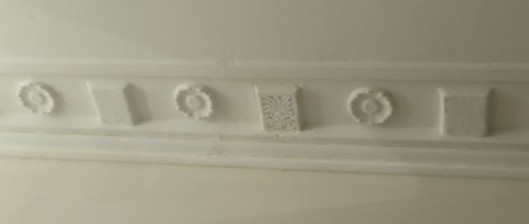It is often decorative details in a property which create value, bring delight, reveal its history, tell of its status. This is particularly true of refurbishment schemes being domestically re-inhabited. Such details can make the house feel more homely – as if age brings comfort, a sense of security, a presence and perhaps a sense of touching the lives of previous inhabitants.
I recently joined the AECB to visit Arboreal Architecture’s energy efficient refurbishment of a Georgian townhouse in Clapham – shortlisted for the AJ Retrofit Awards 2014 in the Heritage category (click here to link to the shortlist). The process of the refurbishment was touched on in a previous post in its achievement of the Silver Standard in the AECB CarbonLite programme – click here to link to the earlier post.
In this post I’d like to share with you something I thought captured a wonderful ‘moment’ in the house’s (hi)story.
The photo shows part of the cornice in the main entrance hall. Harry Paticas of Arboreal Architecture pointed out only one decorative moulding had been restored of accumulated paint layers. Apart from the challenges of sensitive restoration it struck me the moulding’s pristine restoration is made more jewel-like by the adjacent remaining concealed.
I thought this contrast in treatment brought to life the house’s story: it holds promise of that left covered; it tells of decoration left ‘muffled’ over time – expression gradually lost; it reveals eons of lack of skill and care. If all the detail of the cornice had been restored the overall effect may feel more like living in a museum – patina removed to time warp us to the Georgian era.
This example suggests a full restoration is not always necessary – a partial reveal of detail is as much a window into the past as an accurately re-created setting. Each building has its character, and wisdom of its custodians will decide the appropriate treatment of the time.


The effects of restoring the whole cornice could (in my opinion) not only give the impression of living in a museum, but worse could reduce the significance of the moulding. By only revealing the true intricacy of part, the remainder is instantly validated as an original. The countless brushstrokes of previous owners instantly apparent, not simply a contemporary replica slavishly copying a historic aesthetic to the ends of falsifying period features. But as you suggest, the story is as central to the overall effect as the moulding itself; a real moment of joy in this restoration.
LikeLike
Nice article! In the interests of being facetious, however, could this not instead be read as a damning critique of a political environment where naked greed, rising house prices and poor changes to planning law have driven designers to thoughts of better days, all as manifested through the prohibitively high cost of paint stripper? I mean what is that, a sample pot size or something?
LikeLike
James, glad you liked the post!
Perhaps some fun could be had with the mouldings – maybe reveal one at a time on birthdays etc?
LikeLike